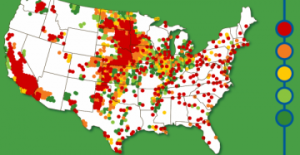Major US Cities Vulnerable to Drought
June 14th, 2013
 Major US cities, including Washington, D.C., New York City, Los Angeles, and San Diego are likely to face water scarcity as climate change increases the potential for drought, according to a study released by the Columbia University Water Center in May.
Major US cities, including Washington, D.C., New York City, Los Angeles, and San Diego are likely to face water scarcity as climate change increases the potential for drought, according to a study released by the Columbia University Water Center in May.
Along with the potentially 40 million Americans affected in these cities, several “breadbasket region” states such as Nebraska, Illinois, and Minnesota were also considered to be vulnerable areas.
The report, America’s Water Risk: Water Stress and Climate Variability, examines how climate could affect “vulnerability to short and long term droughts,”
The study also notes that population growth and increased demand for water in the future will further decrease water availability, if precipitation and water use patterns remain largely unchanged.
“Projecting current trends, if you continue business as usual without any innovation, eventually you’re going to get to a point where you’re not going to have enough water to cover population demands,” Veolia Water Chief Sustainability Officer Edwin Pinero told BNA.
“All cities and all businesses require water, yet in many regions, they need more water than is actually available — and that demand is growing,” said Upmanu Lall, director, Columbia Water Center. “The new study reveals that certain areas face exposure to drought, which will magnify existing problems of water supply and demand.”
The country’s population has increased 99 percent since 1950, while public water withdrawal has increased 50 percent. Total water withdrawals have increased 127 percent in that same time frame, the study found.
The study does not predict when the water scarcity will occur specifically. The findings are based on past patterns of population growth and droughts and take into account climate change’s impact on drought prevalence.
A recent Ernst & Young corporate sustainability study found that 76 percent of corporate representatives chose water as a top resource at risk. Global demand for freshwater is expected to outstrip supply by 40 percent by 2030 and companies in northern India and northern China are already shutting down due to lack of water in the region.
Five factors are exacerbating water scarcity:
- An increasing world population and rising demand for water;
- Water quality degradation in environmentally sensitive watersheds;
- The scale of global deforestation;
- Extreme weather patterns attributable to global warming.
Risk of Flooding
At the other end of the spectrum, the Federal Emergency Management Agency (FEMA) is warning that rising seas and increasingly severe weather are expected to increase the areas of the United States at risk of floods by up to 45 percent by 2100. These changes could double the number of flood-prone properties covered by the National Flood Insurance Program and drastically increase the costs of floods, according to a recent report from the Agency.
Read the story in Mother Jones…
Link to the detailed FEMA report…
Posted in: Faith Responsible Investing, Global, Homepage News, Integrity of Creation, Members, North America, Resources
Related keywords: drought, flooding, water risk


